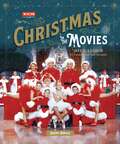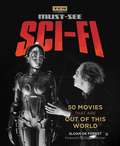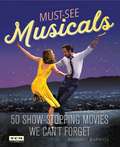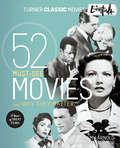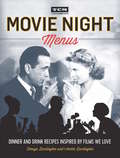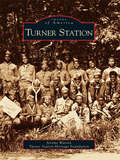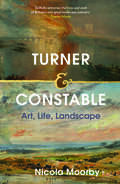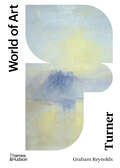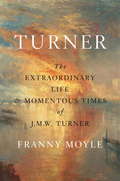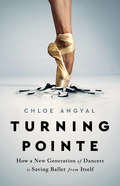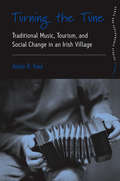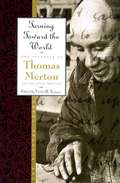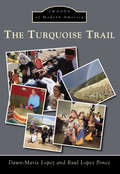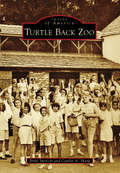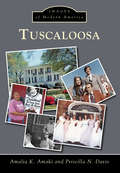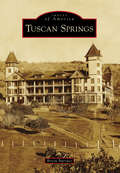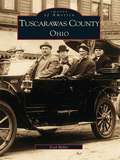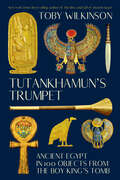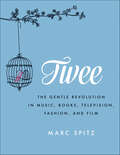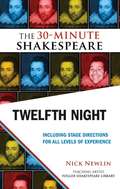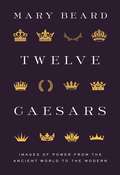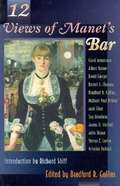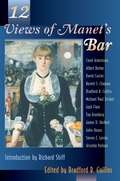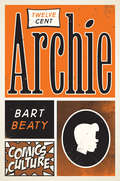- Table View
- List View
Turner Classic Movies: 30 Classics to Celebrate the Season (Turner Classic Movies)
by Jeremy ArnoldTurner Classic Movies presents a bucket list of the best and most beloved holiday films of all time, complete with spirited commentary, behind-the-scenes stories, and photos spanning eight decades of Christmastime favorites.Nothing brings the spirit of the season into our hearts quite like a great holiday movie. "Christmas films" come in many shapes and sizes and exist across many genres. Some, like It's a Wonderful Life and A Christmas Story, are perennials, while others, such as Die Hard, have only gradually become yuletide favorites. But they all have one thing in common: they use themes evoked by the holiday period - nostalgia, joy, togetherness, dysfunction, commercialism, or cynicism - as a force in their storytelling.Turner Classic Movies: Christmas in the Movies showcases the very best among this uniquely spirited strain of cinema. Each film is profiled on what makes it a "Christmas movie," along with behind-the-scenes stories of its production, reception, and legacy. Complemented by a trove of color and black-and-white photos, Turner Classic Movies: Christmas in the Movies is a glorious salute to a collection of the most treasured films of all time.Among the 30 films included: The Shop Around the Corner, Holiday Inn, Meet Me in St. Louis, It's a Wonderful Life, Miracle on 34th Street, White Christmas, A Christmas Story, National Lampoon's Christmas Vacation, Home Alone, Little Women, and The Nightmare Before Christmas.
Turner Classic Movies: 50 Movies That Are Out of This World (Turner Classic Movies)
by Sloan De Forest Roger CormanSpanning nine decades and branded by the most trusted authority on film, Turner Classic Movies: Must-See Sci-Fi showcases 50 of the most shocking, weird, wonderful, and mind-bending movies ever made.From A Trip to the Moon (1902) to Arrival (2016), science fiction cinema has produced a body of classics with a broader range of styles, stories, and subject matter than perhaps any other film genre. They are movies that embed themselves in the depths of the mind, coloring our view of day-to-day reality and probably fueling a few dreams (and nightmares) along the way.In Turner Classic Movies: Must-See Sci-Fi, fifty unforgettable films are profiled, including beloved favorites like The Day the Earth Stood Still (1951) and Fantastic Voyage (1966), groundbreaking shockers like Planet of the Apes (1968) and Alien (1979), and lesser-known landmarks like Things to Come (1936) and Solaris (1972). Illustrated by astounding color and black-and-white images, the book presents the best of this mind-bending genre, detailing through insightful commentary and behind-the-scenes stories why each film remains essential viewing. A perfect gift for any film buff or sci-fi fanatic!
Turner Classic Movies: 50 Show-Stopping Movies We Can't Forget (Turner Classic Movies)
by Richard Barrios Michael FeinsteinSpanning nine decades and showcasing the most memorable songs, dazzling dancing, and brightest stars ever to grace the silver screen, Must-See Musicals is the guide to the greatest musicals of all time from the most trusted authority on film: Turner Classic Movies. Movie musicals have been a part of pop culture since films began to talk, over nine decades ago. From The Jazz Singer in 1927 all the way to La La Land in modern times, musicals have sung and danced over a vast amount of territory, thrilling audiences the entire time. More than any other type of entertainment, musicals transport us to marvelous places: a Technicolor land over the rainbow in The Wizard of Oz; a romantic ballroom where, in Top Hat, Fred Astaire and Ginger Rogers dance cheek to cheek; a London theater where the Beatles perform before hysterical crowds in A Hard Day's Night; even to a seemingly alternate reality where eager throngs still throw rice as they watch The Rocky Horror Picture Show. These titles, and many more, show us that a great musical film is a timeless joy. Covering fifty of the best spanning the dawn of sound to the high-def present, Turner Classic Movies: Must-See Musicals-written by renowned musical historian Richard Barrios-is filled with lush illustrations as well as enlightening commentary and entertaining "backstage" stories about every one of these unforgettable films.
Turner Classic Movies: 52 Must-See Movies and Why They Matter (Turner Classic Movies)
by Jeremy Arnold Robert OsborneShowcasing 52 Essential films from the golden age to the present, Turner Classic Movies invites you into a world filled with stirring performances, dazzling musical numbers, and bold directorial visions that mark the greatest moments in film history. These are movies that define what it means to be a classic. Readers can enjoy one film per week, for a year of stellar viewing, or indulge in their own classic movie festival.
Turner Classic Movies: Dinner and Drink Recipes Inspired by the Films We Love (Turner Classic Movies)
by Tenaya Darlington André DarlingtonLooking for a great idea for date night or to entertain friends? Why not cue up Casablanca with some French 75s and a Moroccan-themed spread? Turner Classic Movies: Movie Night Menus spotlights thirty crowd-pleasing films from the 1930s through the '80s, paired with signatures drinks and dishes that appear in, or are inspired by, each film's setting and stars. Filled with entertaining tips and background on each film, dish, and cocktail, the book offers a unique culinary tour of movie history, including menus inspired by The Thin Man, The Philadelphia Story, Sunset Boulevard, Some Like It Hot, American Graffiti, Moonstruck, and many more.Fully illustrated with luscious food photography and evocative film stills, Movie Night Menus provides the perfect accompaniments and conversation pieces to round out a fun-filled evening.
Turner Station (Images of America)
by Jerome Watson Turner Station Heritage FoundationIn 1888, a passenger freight station was built by the Baltimore and Sparrows Point Railroad on land owned by Joshua J. Turner, a local businessman. The train stop was called Turner Station, and as the nearby community grew, it took on that name. The community's first church, St. Matthews Methodist Church, was founded in 1900, while the first public school, Turner Elementary School, was built in 1925. Adams Bar and Cocktail Lounge, an important entertainment establishment, came into being in 1933. It attracted top acts in African American music and comedy during the 1930s, 1940s, and 1950s, including Red Foxx, Pearl Bailey, and Fats Domino. Turner Station was home to individuals who made lasting contributions to the state and nation, including Dr. Joseph Thomas, physician, businessman, and diplomat; Kweisi Mfume, NAACP president; Calvin Hill, former NFL star; and Kevin Clash, puppeteer.
Turner and Constable: Art, Life, Landscape
by Nicola MoorbyBorn just fourteen months apart, one in London and the other in rural Suffolk, J.M.W. Turner and John Constable went on to change the face of British art. The two men have routinely been seen as polar opposites, not least by their peers. Differing in temperament, background, beliefs and vision, they created images as dissimilar as their personalities. Yet in many ways they were fellow travellers. As children of the late 18 th century, both faced the same challenges and opportunities. Above all, they shared common cause as champions of a distinctively British art. Through their work, they fought for the recognition and appreciation of landscape painting – and in doing so ensured their reputations were forever intertwined and interlinked. Nicola Moorby offers us a fresh perspective on two extraordinary artists, uncovering the layers of fiction that have embellished and disguised their greatest achievements. For Turner & Constable is not just a tale of two artists; it is also the story of the triumph of landscape painting.
Turner: Second Edition (World of Art #0)
by Graham ReynoldsWith clear writing, this is the ideal introduction to J. M. W. Turner’s life and work for anyone interested in British painting in its golden age. Few British artists have ever achieved such a wide range of style in oil painting, watercolor, drawing, and engraving as J. M. W. Turner. This classic book in the World of Art series traces the artist’s career from youthful, picturesque views and watercolors of Gothic ruins, to romantic landscapes and historical compositions, to the darker abstracts of his later career. Though these late works were incomprehensible to his contemporaries, Turner is understood today as one of the greatest British painters because of these pioneering explorations into abstraction, which prefigured the art of the twentieth century. In Turner, Graham Reynolds weaves together the artist’s biography and criticism of his work through all phases of his career, paying particular attention to the importance of foreign travel and the influence of Claude Lorrain and Nicolas Poussin. First published in 1969, Turner has long served as an outstanding introduction to Turner’s life and art. Now with full-color illustrations and a new introduction by David Brown, this updated and revised edition reflects recent discoveries and interpretations of Turner’s work, and will serve as the best available study of the artist for a new generation of readers.
Turner: The Extraordinary Life and Momentous Times of J.M.W. Turner
by Franny MoyleThe life of one of Western art's most admired and misunderstood painters J.M.W. Turner is one of the most important figures in Western art, and his visionary work paved the way for a revolution in landscape painting. Over the course of his lifetime, Turner strove to liberate painting from an antiquated system of patronage. Bringing a new level of expression and color to his canvases, he paved the way for the modern artist. Turner was very much a man of his changing era. In his lifetime, he saw Britain ravaged by Napoleonic wars, revived by the Industrial Revolution, and embarked upon a new moment of Imperial glory with the ascendancy of Queen Victoria. His own life embodied astonishing transformation. Born the son of a barber in Covent Garden, he was buried amid pomp and ceremony in St. Paul's Cathedral. Turner was accepted into the prestigious Royal Academy at the height of the French Revolution when a climate of fear dominated Britain. Unable to travel abroad he explored at home, reimagining the landscape to create some of the most iconic scenes of his country. But his work always had a profound human element. When a moment of peace allowed travel into Europe, Turner was one of the first artists to capture the beauty of the Alps, to revive Venice as a subject, and to follow in Byron's footsteps through the Rhine country. While he was commercially successful for most of his career, Turner's personal life remained fraught. His mother suffered from mental illness and was committed to Bedlam. Turner never married but had several long-term mistresses and illegitimate daughters. His erotic drawings were numerous but were covered up by prurient Victorians after his death. Turner's late, impressionistic work was held up by his Victorian detractors as example of a creeping madness. Affection for the artist's work soured. John Ruskin, the greatest of all 19th century art critics, did what he could to rescue Turner's reputation, but Turner's very last works confounded even his greatest defender. TURNER humanizes this surprising genius while placing him in his fascinating historical context. Franny Moyle brilliantly tells the story of the man to give us an astonishing portrait of the artist and a vivid evocation of Britain and Europe in flux.From the Hardcover edition.
Turning Pointe: How a New Generation of Dancers Is Saving Ballet from Itself
by Chloe AngyalA reckoning with one of our most beloved art forms, whose past and present are shaped by gender, racial, and class inequities—and a look inside the fight for its future Every day, in dance studios all across America, legions of little children line up at the barre to take ballet class. This time in the studio shapes their lives, instilling lessons about gender, power, bodies, and their place in the world both in and outside of dance. In Turning Pointe, journalist Chloe Angyal captures the intense love for ballet that so many dancers feel, while also grappling with its devastating shortcomings: the power imbalance of an art form performed mostly by women, but dominated by men; the impossible standards of beauty and thinness; and the racism that keeps so many people of color out of ballet. As the rigid traditions of ballet grow increasingly out of step with the modern world, a new generation of dancers is confronting these issues head on, in the studio and on stage. For ballet to survive the twenty-first century and forge a path into a more socially just future, this reckoning is essential.
Turning The Tune
by Adam KaulThe last century has seen radical social changes in Ireland, which have impacted all aspects of local life but none more so than traditional Irish music, an increasingly important identity marker both in Ireland and abroad. The author focuses on a small village in County Clare, which became a kind of pilgrimage site for those interested in experiencing traditional music. He begins by tracing its historical development from the days prior to the influx of visitors, through a period called "the Revival," in which traditional Irish music was revitalized and transformed, to the modern period, which is dominated by tourism. A large number of incomers, locally known as "blow-ins," have moved to the area, and the traditional Irish music is now largely performed and passed on by them. This fine-grained ethnographic study explores the commercialization of music and culture, the touristic consolidation and consumption of "place," and offers a critique of the trope of "authenticity," all in a setting of dramatic social change in which the movement of people is constant.
Turning Toward the World
by Thomas Merton"Inexorably life moves on towards crisis and mystery. Everyone must struggle to adjust himself to this, to face the situation for 'now is the judgment of the world.' In a way, each one judges himself merely by what he does. Does, not says. Yet let us not completely dismiss words. They do have meaning. They are related to action. They spring from action and they prepare for it, they clarify it, they direct it." --Thomas Merton, August 16, 1961The fourth volume of Thomas Merton's complete journals, one of his final literary legacies, springs from three hundred handwritten pages that capture - in candid, lively, deeply revealing passages - the growing unrest of the 1960s, which Merton witnessed within himself as plainly as in the changing culture around him.In these decisive years, 1960-1963, Merton, now in his late forties and frequently working in a new hermitage at the Abbey of Gethsemani, finds himself struggling between his longing for a private, spiritual life and the irresistible pull of social concerns. Precisely when he longs for more solitude, and convinces himself he could not cut back on his writing, Merton begins asking complex questions about the contemporary culture ("the 'world' with its funny pants, of which I do not know the name, its sandals and sunglasses"), war, and the churches role in society.Thus despite his resistance, he is drawn into the world where his celebrity and growing concerns for social issues fuel his writings on civil rights, nonviolence, and pacifism and lead him into conflict with those who urge him to leave the moral issues to bishops and theologians.This pivotal volume in the Merton journals reveals a man at the height of a brilliant writing career, marking the fourteenth anniversary of his priesthood but yearning still for the key to true happiness and grace. Here, in his most private diaries, Merton is as intellectually curious, critical, and insightful as in his best-known public writings while he documents his movement from the cloister toward the world, from Novice Master to hermit, from ironic critic to joyous witness to the mystery of God's plan.
Turquoise Trail, The (Images of Modern America)
by Dawn-Marie LopezThe Turquoise Trail National Scenic Byway is located in the heart of Central New Mexico. Linking Albuquerque to Santa Fe, the trail weaves its way north from Tijeras to the Lone Butte area, ending just south of the "City Different." The trail is renowned for its mountainous landscapes, brilliantly painted skies, and diversity of cultures, all of which are reflected in local theater and dance traditions that are found along this 62-mile route. These arts have been important to Native American, Hispanic, and Anglo cultures. There is also a chapter that highlights the flourishing film industry and the popular entertainments of the Turquoise Trail.
Turtle Back Zoo (Images of America)
by Brint Spencer Caitlin A. SharpWith 140 animals of 40 species, the Turtle Back Zoo opened in 1963 as a seasonal children's zoo. The community and county government brought the zoo to life, while the Essex County Park Commission administered its daily functions. With funds generated from the sale of land for highway development, architects and builders selected a fairy tale, Hans Christian Andersen aesthetic for their theme. Once opened, Turtle Back Zoo was an instant success, and its popularity led to it becoming a year-round attraction that appealed to all ages. The family recreation experience came to include wildlife conservation education as well. In the early 2000s, the zoo was renovated, and a first-class animal hospital was built to serve the growing animal collection. The site is now recognized as a first-rate, modern zoo and is accredited by the Association of Zoos & Aquariums.
Tuscaloosa (Images of Modern America)
by Amalia K. Amaki Priscilla N. DavisIn the 1960s, Tuscaloosa drew national attention when the University of Alabama was fully integrated. The decade also marked the arrival of Paul "Bear" Bryant as head coach of Alabama's football team and the majority of Frank Anthony Rose's tenure as president--a period characterized by race mediation and increases in enrollment, assets, and academic standards. For the next 50 years, sports, education, cultural and recreational opportunities, and business developments contributed to the city and the lifestyles of its residents. Tuscaloosa has associations with people such as F. David Mathews (who concurrently served as president of Alabama and as a secretary under Pres. Gerald Ford), writer Richard Yates (Revolutionary Road), actress Sela Ward, and quarterback Joe Namath.
Tuscan Spaces
by Silvia M. RossAn important locus for English-speaking writers, the region of Tuscany is also well represented in the Italian literary canon. In Tuscan Spaces, Silvia Ross focuses on constructions of Tuscany in twentieth-century Italian literature and juxtaposes them with English prose works by such authors as E.M. Forster and Frances Mayes to expose the complexity of literary representation centred on a single milieu.Ross uses the works of writers such as Federigo Tozzi, Aldo Palazzeschi, Vasco Pratolini, and Elena Gianini Belotti, to seek out alternative visions of Tuscan space and emphasizes that each author fashions the region in a manner which reflects their personal poetics, background, and experiences. Theories of cultural geography, space, travel, and narrative contribute to Ross's consideration of the dualisms commonly employed in writings about Tuscany, such as country/city, nature/culture, female/male, and self/other, all of which are in turn affected by her interrogation of the local/foreign opposition that underlies the study as a whole.
Tuscan Springs (Images of America)
by Bryon BurrussTuscan Springs, originally "Lick Springs," was a collection of mineral waters near Red Bluff, California, which Native Americans considered such sacred ground that even warring tribes would lay down their weapons and bathe there together in peace. It was here that Dr. John A. Veatch became the first person in America to discover "white gold" (borax) in 1856, and he renamed the site after the fumaroles of Italy. While plans to extract the mineral proved impractical, word quickly spread of the healing properties of these alleged miraculous springs, and hundreds soon "were taking the waters." But, it was not until the property fell into the hands of an ambitious local merchant, Edgerton Walbridge--equal parts Teddy Roosevelt, William Randolph Hearst, and P.T. Barnum--that the springs gained worldwide fame, drawing visitors to Tehama County from throughout the country by carriage, railroad, and steamboat.
Tuscarawas County, Ohio (Images of America)
by Fred MillerAlthough comprised of only 18 communities, Tuscarawas County, Ohio boasts a long and varied history. Incorporated in 1808, it is rich in Native American and early pioneer lore. It is the birthplace of the first pioneer settlement in the Ohio Country (1772-1777), and was home to the only Revolutionary War Fort in the state, erected in 1778 near Bolivar, Ohio. Baseball great Cy Young was born and is buried here. The Society of Separatists of Zoar experimented with one of the most successful endeavors in communal living in American history. Coal mines, a significant source of employment for residents of the county, dotted the countryside. The Ohio Erie Canal, which ran the entire length of the county, provided transportation for area goods and people. Major flooding in 1913 caused intensive damage to low-lying settlements. More recently, archaeological expeditions have sketched an image of early life in these communities, and have even uncovered a Revolutionary War Burial Site.
Tutankhamun's Trumpet: Ancient Egypt In 100 Objects From The Boy-king's Tomb
by Toby WilkinsonMarking the one hundredth anniversary of the discovery of Tutankhamun’s magnificent tomb, its incredible treasures are revealed as never before. In 1922, after fifteen years of searching, archaeologists finally discovered the tomb of King Tutankhamun. There, buried alongside the king’s mummy, they found more than 5,000 unique objects, from the mundane to the extravagant, from the precious to the everyday. Tutankhamun’s spectacular gold mask is justifiably famous, but the rest of the treasures remain largely unknown, their stories untold. In this rich and beautifully illustrated work of history, renowned Egyptologist Toby Wilkinson allows one hundred artifacts from the boy king’s tomb to speak again—not only for themselves, but as witnesses of the civilization that created them. A gold-decorated chariot reveals the impressive scale of Egyptian technology. Loaves of bread, baskets of fruit, and jars of wine hint at the fertility of the Nile Valley and the abundant feasts enjoyed by its people. Ebony and ivory from Nubia and a jewel of Libyan desert glass show the range of Egypt’s trading and diplomatic networks. Shaving equipment and board games provide a window into the everyday lives of the people. And perhaps most poignant of all the objects in the tomb is one that conjures up a lost world of human experience: Tutankhamun’s silver trumpet. Through these treasures, Wilkinson bring us face-to-face with the culture of the pharaohs, its extraordinary development, its remarkable flourishing, and its lasting impact. Filled with surprising insights and vivid details, Tutankhamun’s Trumpet offers an indelible portrait of the history, people, and legacy of ancient Egypt.
Twee: The Gentle Revolution in Music, Books, Television, Fashion, and Film
by Marc SpitzNew York Times, Spin, and Vanity Fair contributor Marc Spitz explores the first great cultural movement since Hip Hop: an old-fashioned and yet highly modern aesthetic that’s embraced internationally by teens, twenty and thirty-somethings and even some Baby Boomers; creating hybrid generation known as Twee. Via exclusive interviews and years of research, Spitz traces Generation Twee’s roots from the Post War 50s to its dominance in popular culture today.Vampire Weekend, Garden State, Miranda July, Belle and Sebastian, Wes Anderson, Mumblecore, McSweeney’s, Morrissey, beards, artisanal pickles, food trucks, crocheted owls on Etsy, ukuleles, kittens and Zooey Deschanel—all are examples of a cultural aesthetic of calculated precocity known as Twee.In Twee, journalist and cultural observer Marc Spitz surveys the rising Twee movement in music, art, film, fashion, food and politics and examines the cross-pollinated generation that embodies it—from aging hipsters to nerd girls, indie snobs to idealistic industrialists. Spitz outlines the history of twee—the first strong, diverse, and wildly influential youth movement since Punk in the ’70s and Hip Hop in the ’80s—showing how awkward glamour and fierce independence has become part of the zeitgeist.Focusing on its origins and hallmarks, he charts the rise of this trend from its forefathers like Disney, Salinger, Plath, Seuss, Sendak, Blume and Jonathan Richman to its underground roots in the post-punk United Kingdom, through the late’80s and early ’90s of K Records, Whit Stillman, Nirvana, Wes Anderson, Pitchfork, This American Life, and Belle and Sebastian, to the current (and sometimes polarizing) appeal of Girls, Arcade Fire, Rookie magazine, and hellogiggles.com.Revealing a movement defined by passionate fandom, bespoke tastes, a rebellious lack of irony or swagger, the championing of the underdog, and the vanquishing of bullies, Spitz uncovers the secrets of modern youth culture: how Twee became pervasive, why it has so many haters and where, in a post-Portlandia world, can it go from here?
Twelfth Night: The 30-Minute Shakespeare
by Nick NewlinPlanning a school or amateur Shakespeare production? The best way to experience the plays is to perform them, but getting started can be a challenge: The complete plays are too long and complex, while scene selections or simplified language are too limited."The 30-Minute Shakespeare" is a new series of abridgements that tell the "story" of each play from start to finish while keeping the beauty of Shakespeare's language intact. Specific stage directions and character suggestions give even inexperienced actors the tools to perform Shakespeare with confidence, understanding, and fun!This cutting of TWELFTH NIGHT, Shakespeare's bittersweet comic masterpiece, consists of three classic scenes. After an extended introductory narration, the action begins with Feste the Fool consoling a mourning Lady Olivia with wit and wordplay. Viola (disguised as a male Cesario) woos Olivia on behalf of Duke Orsino, but Olivia falls for the messenger Viola/Cesario instead. The final scene in Olivia's kitchen gives young actors an easy and specific way to play late-night revelry, as Sir Toby Belch and his friends amuse themselves with the censorious but ultimately hapless Malvolio. One highlight of the production is a group "rap" version of the song "Come Away Death."The edition also includes an essay by editor Nick Newlin on how to produce a Shakespeare play with novice actors, and notes about the original production of this abridgement at the Folger Shakespeare Library's annual Student Shakespeare Festival.
Twelve Caesars: Images of Power from the Ancient World to the Modern (The A. W. Mellon Lectures in the Fine Arts #60)
by Mary BeardFrom the bestselling author of SPQR: A History of Ancient Rome, the fascinating story of how images of Roman autocrats have influenced art, culture, and the representation of power for more than 2,000 yearsWhat does the face of power look like? Who gets commemorated in art and why? And how do we react to statues of politicians we deplore? In this book—against a background of today’s “sculpture wars”—Mary Beard tells the story of how for more than two millennia portraits of the rich, powerful, and famous in the western world have been shaped by the image of Roman emperors, especially the “Twelve Caesars,” from the ruthless Julius Caesar to the fly-torturing Domitian. Twelve Caesars asks why these murderous autocrats have loomed so large in art from antiquity and the Renaissance to today, when hapless leaders are still caricatured as Neros fiddling while Rome burns.Beginning with the importance of imperial portraits in Roman politics, this richly illustrated book offers a tour through 2,000 years of art and cultural history, presenting a fresh look at works by artists from Memling and Mantegna to the nineteenth-century American sculptor Edmonia Lewis, as well as by generations of weavers, cabinetmakers, silversmiths, printers, and ceramicists. Rather than a story of a simple repetition of stable, blandly conservative images of imperial men and women, Twelve Caesars is an unexpected tale of changing identities, clueless or deliberate misidentifications, fakes, and often ambivalent representations of authority.From Beard’s reconstruction of Titian’s extraordinary lost Room of the Emperors to her reinterpretation of Henry VIII’s famous Caesarian tapestries, Twelve Caesars includes fascinating detective work and offers a gripping story of some of the most challenging and disturbing portraits of power ever created.Published in association with the Center for Advanced Study in the Visual Arts, National Gallery of Art, Washington, DC
Twelve Views of Manet's Bar
by Bradford R. CollinsThe author has assembled here a collection of twelve essays that demonstrates, through the interpretation of a single work of art, the abundance and complexity of methodological approaches now available to art historians.
Twelve Views of Manet's Bar (Princeton Series in 19th Century Art, Culture, and Society #1)
by Bradford R. CollinsBradford Collins has assembled here a collection of twelve essays that demonstrates, through the interpretation of a single work of art, the abundance and complexity of methodological approaches now available to art historians. Focusing on Manet's A Bar at the Folies-Bergère, each contributor applies to it a different methodology, ranging from the more traditional to the newer, including feminism, Marxism, Lacanian psychoanalysis, and semiotics. By demonstrating the ways that individual practitioners actually apply the various methodological insights that inform their research, Twelve Views of Manet's "Bar" serves as an excellent introduction to critical methodology as well as a provocative overview for those already familiar with the current discourse of art history. In the process of gaining new insight into Manet's work, and into the discourse of methodology, one discovers that it is not only the individual painting but art history itself that is under investigation. An introduction by Richard Shiff sets the background with a brief history of Manet scholarship and suggestions as to why today's accounts have taken certain distinct directions. The contributors, selected to provide a broad and balanced range of methodological approaches, include: Carol Armstrong, Albert Boime, David Carrier, Kermit Champa, Bradford R. Collins, Michael Paul Driskel, Jack Flam, Tag Gronberg, James D. Herbert, John House, Steven Z. Levine, and Griselda Pollock.
Twelve-Cent Archie: New edition with full color illustrations
by Bart BeatyFor over seventy-five years, Archie and the gang at Riverdale High have been America’s most iconic teenagers, delighting generations of readers with their never-ending exploits. But despite their ubiquity, Archie comics have been relatively ignored by scholars—until now.Twelve-Cent Archie is not only the first scholarly study of the Archie comic, it is an innovative creative work in its own right. Inspired by Archie’s own concise storytelling format, renowned comics scholar Bart Beaty divides the book into a hundred short chapters, each devoted to a different aspect of the Archie comics. Fans of the comics will be thrilled to read in-depth examinations of their favorite characters and motifs, including individual chapters devoted to Jughead’s hat and Archie’s sweater-vest. But the book also has plenty to interest newcomers to Riverdale, as it recounts the behind-the-scenes history of the comics and analyzes how Archie helped shape our images of the American teenager. As he employs a wide range of theoretical and methodological approaches, Beaty reveals that the Archie comics themselves were far more eclectic, creative, and self-aware than most critics recognize. Equally comfortable considering everything from the representation of racial diversity to the semiotics of Veronica’s haircut, Twelve-Cent Archie gives a fresh appreciation for America’s most endearing group of teenagers.
